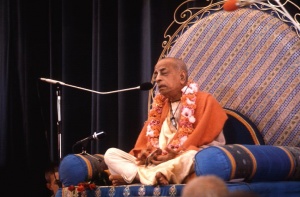CC Madhya 6.139: Difference between revisions
m (1 revision(s)) |
(Vanibot #0054 edit - transform synonyms into clickable links, which search similar occurrences) |
||
| (One intermediate revision by one other user not shown) | |||
| Line 1: | Line 1: | ||
{{ | [[Category:Sri Caitanya-caritamrta - Madhya-lila Chapter 06|C139]] | ||
<div style="float:left">'''[[Sri Caitanya-caritamrta|Śrī Caitanya-caritāmṛta]] - [[CC Madhya|Madhya-līlā]] - [[CC Madhya 6|Chapter 6: The Liberation of Sārvabhauma Bhaṭṭācārya]]'''</div> | |||
<div style="float:right">[[File:Go-previous.png|link=CC Madhya 6.138|Madhya-līlā 6.138]] '''[[CC Madhya 6.138|Madhya-līlā 6.138]] - [[CC Madhya 6.140|Madhya-līlā 6.140]]''' [[File:Go-next.png|link=CC Madhya 6.140|Madhya-līlā 6.140]]</div> | |||
{{CompareVersions|CC|Madhya 6.139|CC 1975|CC 1996}} | |||
{{RandomImage}} | |||
==== TEXT 139 ==== | ==== TEXT 139 ==== | ||
<div | <div class="verse"> | ||
veda-purāṇe kahe brahma-nirūpaṇa | :veda-purāṇe kahe brahma-nirūpaṇa | ||
sei brahma—bṛhad-vastu, īśvara-lakṣaṇa | :sei brahma—bṛhad-vastu, īśvara-lakṣaṇa | ||
</div> | </div> | ||
| Line 12: | Line 16: | ||
==== SYNONYMS ==== | ==== SYNONYMS ==== | ||
<div | <div class="synonyms"> | ||
veda- | ''[//vanipedia.org/wiki/Special:VaniSearch?s=veda&tab=syno_o&ds=1 veda]-[//vanipedia.org/wiki/Special:VaniSearch?s=purāṇe&tab=syno_o&ds=1 purāṇe]'' — in the ''Vedas'' and the ''Purāṇas''; ''[//vanipedia.org/wiki/Special:VaniSearch?s=kahe&tab=syno_o&ds=1 kahe]'' — it is stated; ''[//vanipedia.org/wiki/Special:VaniSearch?s=brahma&tab=syno_o&ds=1 brahma]-[//vanipedia.org/wiki/Special:VaniSearch?s=nirūpaṇa&tab=syno_o&ds=1 nirūpaṇa]'' — explaining the Supreme; ''[//vanipedia.org/wiki/Special:VaniSearch?s=sei&tab=syno_o&ds=1 sei] [//vanipedia.org/wiki/Special:VaniSearch?s=brahma&tab=syno_o&ds=1 brahma]'' — that Supreme; ''[//vanipedia.org/wiki/Special:VaniSearch?s=bṛhat&tab=syno_o&ds=1 bṛhat]-[//vanipedia.org/wiki/Special:VaniSearch?s=vastu&tab=syno_o&ds=1 vastu]'' — the greatest; ''[//vanipedia.org/wiki/Special:VaniSearch?s=īśvara&tab=syno_o&ds=1 īśvara]-[//vanipedia.org/wiki/Special:VaniSearch?s=lakṣaṇa&tab=syno_o&ds=1 lakṣaṇa]'' — feature of the Supreme Personality. | ||
</div> | </div> | ||
| Line 19: | Line 23: | ||
==== TRANSLATION ==== | ==== TRANSLATION ==== | ||
<div | <div class="translation"> | ||
“All the Vedas and literature that strictly follows the Vedic principles explain that the Supreme Brahman is the Absolute Truth, the greatest of all, and a feature of the Supreme Lord. | “All the Vedas and literature that strictly follows the Vedic principles explain that the Supreme Brahman is the Absolute Truth, the greatest of all, and a feature of the Supreme Lord. | ||
</div> | </div> | ||
| Line 26: | Line 30: | ||
==== PURPORT ==== | ==== PURPORT ==== | ||
<div | <div class="purport"> | ||
The greatest of everything is Śrī Kṛṣṇa. Lord Kṛṣṇa states in the Bhagavad-gītā ([[BG 15.15]]), vedaiś ca sarvair aham eva vedyaḥ: “By all the Vedas, I am to be known.” In Śrīmad-Bhāgavatam ([[SB 1.2.11]]) it is said that the Absolute Truth is understood in three phases—namely, Brahman, Paramātmā and Bhagavān, the Supreme Personality of Godhead (brahmeti paramātmeti bhagavān iti śabdyate). Thus the Supreme Personality of Godhead is the last word in understanding the Absolute Truth, Brahman. | The greatest of everything is Śrī Kṛṣṇa. Lord Kṛṣṇa states in the [[Bhagavad-gita As It Is (1972)|''Bhagavad-gītā'']] ([[BG 15.15 (1972)|BG 15.15]]), ''vedaiś ca sarvair aham eva vedyaḥ:'' “By all the ''Vedas'', I am to be known.” In [[Srimad-Bhagavatam|''Śrīmad-Bhāgavatam'']] ([[SB 1.2.11]]) it is said that the Absolute Truth is understood in three phases—namely, Brahman, Paramātmā and Bhagavān, the Supreme Personality of Godhead (''brahmeti paramātmeti bhagavān iti śabdyate''). Thus the Supreme Personality of Godhead is the last word in understanding the Absolute Truth, Brahman. | ||
</div> | </div> | ||
__NOTOC__ | |||
<div style="float:right; clear:both;">[[File:Go-previous.png|link=CC Madhya 6.138|Madhya-līlā 6.138]] '''[[CC Madhya 6.138|Madhya-līlā 6.138]] - [[CC Madhya 6.140|Madhya-līlā 6.140]]''' [[File:Go-next.png|link=CC Madhya 6.140|Madhya-līlā 6.140]]</div> | |||
__NOTOC__ | |||
__NOEDITSECTION__ | |||
Latest revision as of 23:39, 19 February 2024

A.C. Bhaktivedanta Swami Prabhupada
TEXT 139
- veda-purāṇe kahe brahma-nirūpaṇa
- sei brahma—bṛhad-vastu, īśvara-lakṣaṇa
SYNONYMS
veda-purāṇe — in the Vedas and the Purāṇas; kahe — it is stated; brahma-nirūpaṇa — explaining the Supreme; sei brahma — that Supreme; bṛhat-vastu — the greatest; īśvara-lakṣaṇa — feature of the Supreme Personality.
TRANSLATION
“All the Vedas and literature that strictly follows the Vedic principles explain that the Supreme Brahman is the Absolute Truth, the greatest of all, and a feature of the Supreme Lord.
PURPORT
The greatest of everything is Śrī Kṛṣṇa. Lord Kṛṣṇa states in the Bhagavad-gītā (BG 15.15), vedaiś ca sarvair aham eva vedyaḥ: “By all the Vedas, I am to be known.” In Śrīmad-Bhāgavatam (SB 1.2.11) it is said that the Absolute Truth is understood in three phases—namely, Brahman, Paramātmā and Bhagavān, the Supreme Personality of Godhead (brahmeti paramātmeti bhagavān iti śabdyate). Thus the Supreme Personality of Godhead is the last word in understanding the Absolute Truth, Brahman.